#eite icons
Explore tagged Tumblr posts
Text










𓂃 @shuasfilm
#ꕀ⠀ ⠀◢◤⠀ ⠀ᶻz⠀ ⠀jimetal#shuasfilm : the cartoon event#kpop#kpop moodboard#kpop layouts#kpop icons#kpop gg#kdecor#kpop decor#banana joe moodboard#banana joe#the amazing world of gumball#gumball moodboard#food moodboard#banana moodboard#yellow moodboard#silly moodboard#lq moodboard#black moodboard#grey moodboard#messy moodboard#messy layouts#messy icons#sia eite#sia moodboard#eite moodboard#eite icons#server layouts#server icons#gg icons
121 notes
·
View notes
Text








Love One Icons
Requests Are Open For Concept Photos
#kpop#kpop icons#love one#loveone#love one icons#love one yuna#love one yuna icons#love one chaei#love one chaei icons#eite chaehyun icons
2 notes
·
View notes
Text
Top 15 Evil Clowns

There are many fears one might consider “popular phobias.” These are terrors that are not only common amongst people in general, but frequently used, abused, and homaged in various works of popular media. They’re the sources of many famous movies and monsters. Among these popular fears you’ll see folks return to time and time again are arachnophobia, ophidiophobia, galeophobia (look up what all those words mean, I’m not telling you here)...and, of course, coulrophobia. The Fear of Clowns.
In reality, most clowns are not scary at all. They’re figures of fun and whimsy intended to make people laugh and entertain children. They work hard to practice their craft and usually do what they do either for want of money, or love of their career, or even both. However, over time, the imagery of the clown has become increasingly negatively stereotyped, to the point where it’s actually really hard to find genuinely friendly, humorous clown characters in fiction that have a lot of impact. There are a few, mind you - Bozo, Ronald McDonald, and Clarabell are three hopefully recognizable “good clown” names - but nowadays, most people see clowns in the same vein as zombies or vampires. Their innocent origins now seem almost forgotten, and as a result, the fear has become even more intense.
It’s not surprising, to be fair, that the clown has become so synonymous with evil as opposed to happiness. As many have pointed out (who are wiser than I), their heavily made-up faces and flamboyant costumes not only make for eye-catching and iconic visual elements, regardless of the circumstances, but can also make it difficult for people - especially very young people - to fully “connect” with them. As humans, we rely on certain features and physical attributes to tell what others are thinking or intending, and when they are covered up especially heavily, we naturally become unsettled. Beyond this, however, there’s also a wonderful dichotomy inherent to the idea of the Evil Clown: it’s the mismatch between the colorful, often humorous exteriors and the dark, horrific internal processes going on. They can be silly and fun, but they can also be dangerous. This applies to every form the iconography can take, from cartoon baddies to horror film bogeymen.
While I, myself, have no inherent fear of clowns, I’ve always found the idea of the Evil Clown to be fascinating. So, I thought it would be fun, as part of my October-fest of lists for 2024, to cover the topic and name some of my personal favorite examples of the trope. Some are scary, some are just cartoonishly nasty, but all of them universally give clowns a bad name. So, without further ado, here are My Top 15 Favorite Evil Clowns!

15. The Birthday Bandit, from Teamo Supremo.
Of all the characters on this list, the Birthday Bandit is arguably the least threatening, and one of the least well-known. While both of these facts hamper his ranking, he’s still worth mentioning. “Teamo Supremo” was a children’s superhero series made by Disney, inspired by a combination of old superhero shows from the 60s and 70s, and the works of Jay Ward - the creator of Rocky & Bullwinkle, George of the Jungle, and Dudley Do-Right, among other things. It focused on the adventures of three child superheroes; one of their most popular antagonists was the Birthday Bandit. The Bandit was a disgruntled children’s entertainer who turned to crime; while he mostly targeted birthday events, he would also strike on holidays and other special occasions. The main thing that makes the character so memorable, in my opinion, is voice: the Bandit was played by none other than Mark Hamill…and don’t worry, we’ll get to a certain OTHER famous clown of cruelty Hamill has played later in the list. We’re just getting started, ladies and gentlemen…

14. The Clown at Midnight.
This somewhat obscure horror-mystery venture was a made-for-TV film originally produced in Canada. Depending on where you look, the release date is listed as either 1998 or 1999, my guess being depending on the country you look at. While by no means a masterpiece of morbidity, it’s still a decently creepy adventure, in my opinion. The story begins when a young lady named Kate learns she is the daughter of a former opera star, who was killed under mysterious circumstances. She and her friends decide to try and restore the old opera house where her late mother worked. However, things take a turn for the deadly when a mysterious killer, dressed a clown, begins to stalk the teens and their teacher. Kate and her friends must try to figure out who is behind the makeup, while also attempting to stay alive. I won’t give away who the Clown is, or why they’re doing what they’re doing, but it’s the actor involved and the clown himself, as well as the atmosphere of the old opera house, that makes this movie worthwhile.
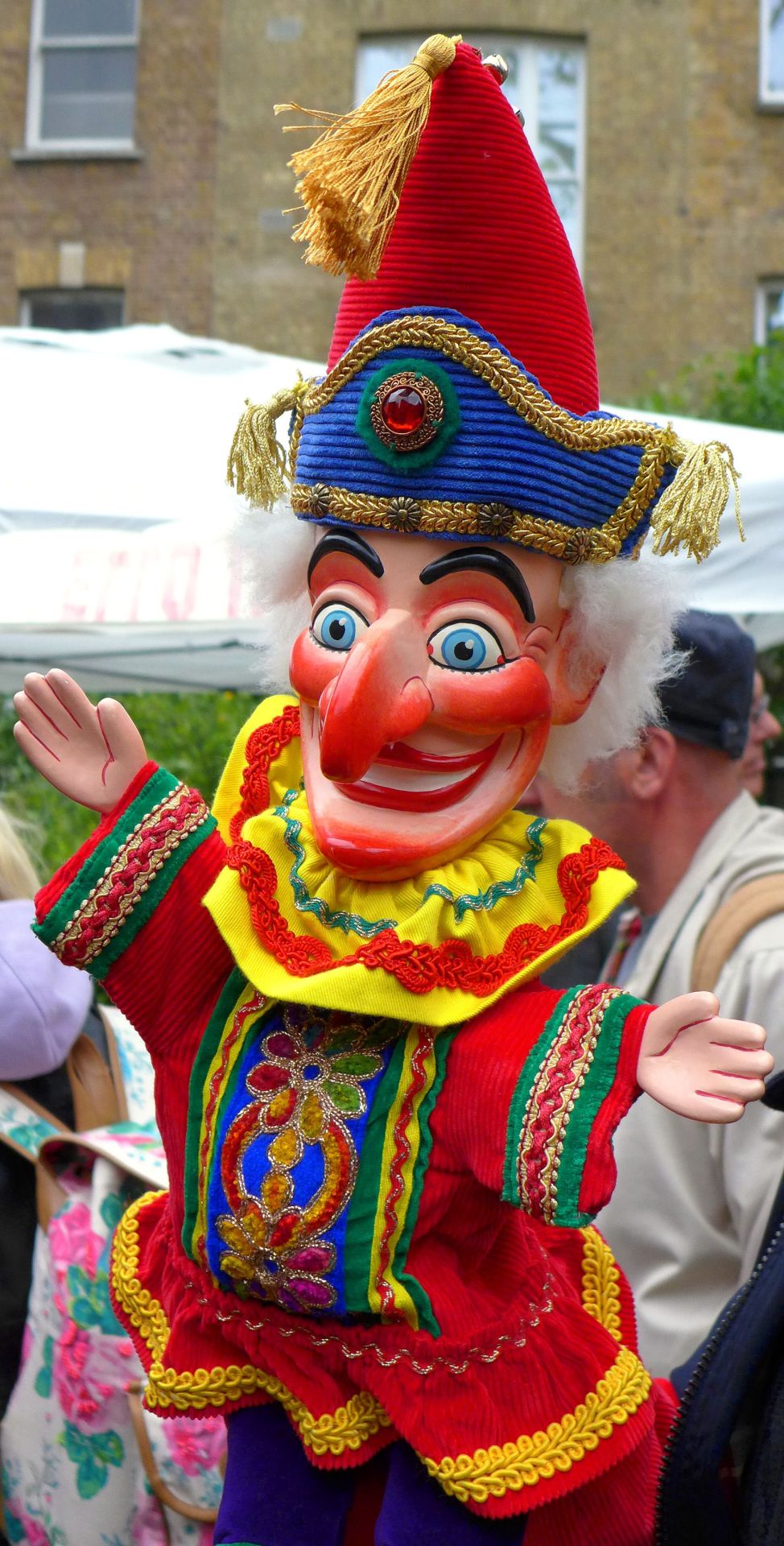
13. Punchinello, a.k.a. Mr. Punch.
The character of Punch, or more appropriately “Punchinello,” is one of the oldest examples of an evil clown in recorded fiction. Now, some of you may be thinking, “What? That silly slapstick puppet show that showed up in ‘Santa Clause 2’? Does that even count?” Well, yes: few people realize the origins of Mr. Punch are really quite disturbing. “Punchinello” is a type of clown character, and the famous figure from “Punch & Judy” is not nearly the innocent weirdo you probably would expect. The origins of Punch indicate he may not even be human, and in the classic Punch & Judy show…yeah, he’s a psychopath. He murders his wife, his child, his neighbor, a policeman, abuses various animals, and even clobbers the Devil himself just to keep his own soul out of Hell! While it’s all given this darkly humorous slapstick veneer, when you really look at the character and his actions, they’re pretty messed up. While I’ve always had a fascination with this folkloric figure, I count him low on the list because he’s really more recognizable as a character in a puppet show than anything else. Which, to me, kind of makes him sit in an odd place compared to other characters on the countdown. And while most people are vaguely familiar with the idea of “Punch & Judy,” I doubt very many really realize how thoroughly INSANE Punchinello is. Other clowns to come are much more overt in their darkness, and most of them are likely more recognizable AS clowns.
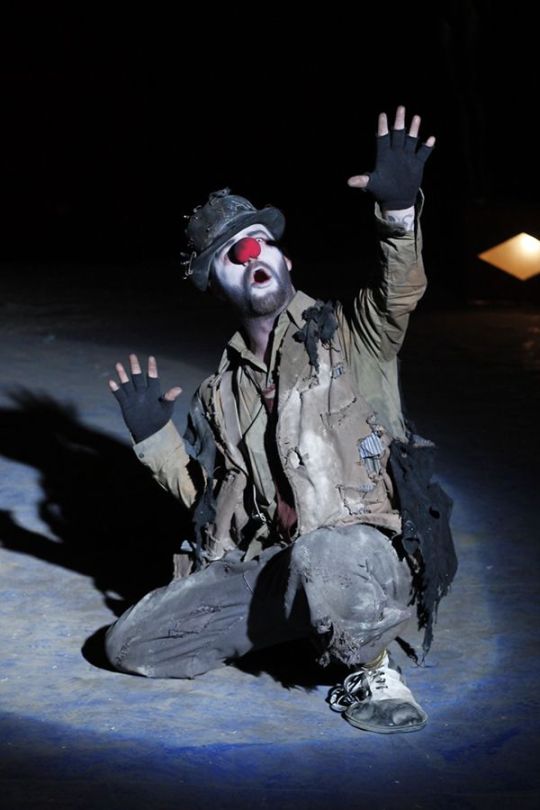
12. The Hobo Clown, from The Devil’s Carnival.
“The Devil’s Carnival” is a short independent musical movie, focused on three people who all end up damned to Hell at the exact same time. They soon discover that Hell is not the medieval fire-and-brimstone wasteland you might expect, but instead takes the form of a perverse carnival and circus. The three sinners thus face a challenge: if they can overcome their greatest sins in life, they will have a chance to go to Heaven. If not, they will be forever doomed to perform in the Carnival, facing death and torture for all eternity as punishment. The Hobo Clown is one of the demons working at the Carnival, and acts as one of two devils assigned to take care of the vain and greedy Miss Merrywood. The character was played by Ivan Moody - most famous as the lead singer of the band Five Finger Death Punch - and gets arguably the best song in the film, “A Penny For a Tale” - performed as he and his fellow carnies torment Merrywood after she fails her test. The film has a motif themed around Aesop’s Fables, and the song analogizes Merrywood’s downfall as a musical retelling of the fable of “The Dog and Her Reflection.” While this dark clown’s role in his respective source is relatively small, it is certainly VERY memorable.

11. Violator, from Spawn.
When most people think of evil clowns in comics, they most likely first think of Batman’s Joker. (And again, we’ll be getting to him soon enough.) However, the Caped Crusader is not the only comic book superhero to have a crazed and murderous clown for an arch-nemesis. Enter Violator - the arch-nemesis of Spawn. While I haven’t actually read much of the Spawn comics, I am primarily familiar with the character thanks to the (admittedly terrible) film adaptation, and (more importantly) the HBO animated series. The former had John Leguizamo, of all people, in the role (and he is arguably the best part of the movie), while the character was voiced by Michael Nicolosi in the TV series. Across all media, however, the character’s basic setup remains the same: Violator is a vaguely bug-like demon who typically takes the form of a crass, vulgar, sardonic clown as a disguise. Ostensibly, he’s in charge of training Spawn, so you’d think they’d be allies…but the Violator is resentful of his position, and only becomes more antagonistic when Spawn goes against his role as leader of Hell’s forces to fight against the Devil. Much of Violator’s evil comes from him trying to one-up his human-born rival, but he’s generally just an awful creature who enjoys suffering and violence in general. When you have a name like “Violator,” I think it’s a given you’re going to be pretty nasty by default.

10. Canio, from Pagliacci.
Alongside Punchinello, this is the oldest example on our list. It’s also the most arguable: while Canio is by no means a hero, it’s debatable how “evil” this clown really is. “Pagliacci” is one of the most well-known operas in the world. Composed by Ruggero Leoncavallo, it tells the story of a troupe of commedia dell’arte performers: chief among them is Canio, who plays the role of the clown Pagliacco in their shows. Canio is depicted as a devoted and kind husband to one of his fellow performers, Nedda…so, when he discovers Nedda is cheating on him with yet another one of their fellow actors, but doesn’t know which one, he plots to find out who her lover is and get revenge. SPOILER ALERT - this ends with Canio, unable to continue his next performance in his emotional distress, murdering both Nedda and her lover, Silvio, before the horrified audience. Canio is a complicated character: on the one hand, he’s typically shown in a sympathetic light: his love for Nedda appears genuine, and he doesn’t seem to be a cruel or abusive husband. HOWEVER, it’s indicated early on that Nedda is afraid of his temper and his possessive attitude towards her, which is why she begins her affair with Silvio. It’s not till he discovers the affair that Canio’s dark side comes out in full force, and even then, one can understand his impulsive and emotional actions. However, Nedda and Silvio aren’t depicted as necessarily bad people, either; they aren’t plotting to do any harm to Canio, and their own relationship seems equally genuine. There’s a lot of gray area here. Ultimately, I would say that double-homicide fueled by rage - however justifiable the act may or may not be - definitely counts Canio in the “Evil Clown” category.
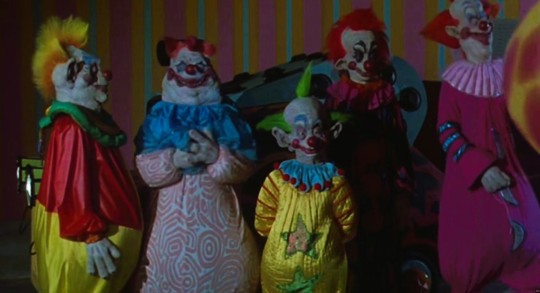
9. Killer Klowns from Outer Space.
While Canio’s villainy is debatable, there’s no such argument to be made with the titular monsters in this cult classic horror-comedy. I mean, it comes with the name: they’re called “Killer Klowns” for a reason. As the title indicates, this movie focuses on a horde of carnivorous, clown-like extraterrestrials, who come to Earth seeking fresh prey to feast upon. The Klowns have powers and weapons that match their circus-like demeanors: they wrap people up in acidic cotton candy cocoons, hatch from eggs that resemble popcorn, have a spaceship that resembles a Big Top, and their only weak spots are their round, red clown noses. While the film is intentionally done in a cheesy, satirical style - fully absorbed in its own silly premise - these Klowns are a great example of what makes the trope so good. They are very funny and utterly bizarre, but they’re also depicted as being totally and completely evil, and have moments where they are genuinely creepy and disturbing. It’s clear that they fully enjoy their own sadistic antics, and take great delight in toying with the humans they kill and consume. The Klowns themselves, and the movie they hail from, are considered classic examples of the concept of Evil Clowns, and were so popular they even spawned a video game, where players are able to take control of the Killer Klowns and hunt down humans in a variety of absurdly despicable ways. I’ve never played the game, but if it’s in any way a match for the movie, I can only imagine it’s as fun as it is freaky.

8. Umlaut, from CarnEvil.
Speaking of video game clowns (as we did at the end of our previous pick), when it comes to the concept of evil circuses, carnivals, and so on, one game title always automatically comes to my mind: “CarnEvil.” A dark staple of arcade galleries from 1998 well into the 2000s, this - like Killer Klowns from Outer Space - was a combo of horror and humor. The game focuses on a thrillseeking protagonist who summons the titular CarnEvil: a twisted amusement park filled with monsters, ghosts, zombies, and…um…evil Christmas elves (no comment), all run by the mad showman, Ludwig Von Tokkentaker. Of course, psychotic killer clowns are all the rage at this place…and the most noteworthy among them all is our “host,” Umlaut. This disembodied jester’s skull - who flies around with his belled collar acting like a helicopter propeller - is the game’s mascot, and acts as Tokkentaker’s second-in-command. Throughout the our gory and grisly adventure, he introduces the different levels, giving each one a darkly humorous limerick to accompany them. In the climactic final sequence aboard his master’s phantom zeppelin, Umlaut confronts the player directly as a mini-boss, preluding the grand showdown between the MC and the leader of CarnEvil. As the most recognizable character from one of the most deliciously deranged arcade experiences of all time, Umlaut definitely deserves a place in my personal top ten.

7. Joker (a.k.a. Rascal), from Smile! Pretty Cure/Glitter Force.
There are quite a number of evil clowns, jesters, harlequins, and so on in the world of anime. A couple that I enjoy who didn’t make the cut include the Moderate Harlequin Alliance from “That Time I Got Reincarnated as a Slime” (yes, both of those titles are things), and Saggi the Dark Clown from “Yu-Gi-Oh!” However, my favorite example from anime would have to be this character. “Smile! Pretty Cure” is one entry in the long-running “Pretty Cure” franchise…and it’s also the ONLY PreCure series I’ve ever seen. (I’m not really a huge fan of Magical Girl shows.) The series is themed around fairy-tales, with three of its major antagonists - Wolfrun, Akaoni, and Majorina - all being characters from famous fairy-tales, and the show as a whole featuring references to other stories and fairy-tale elements throughout. With that said, the main antagonist of the show appears to be a totally original character, and that is this guy. In the original Japanese version, he’s referred to as “Joker.” The English Dub, which retitled the series as “Glitter Force,” changed nearly all of the major character names and other bits of terminology; in that version, the character was renamed “Rascal.” While the original Japanese version is definitely better, I’m going to refer to the character by that name in this description, simply because I find “Rascal” to be a more unique name than “Joker.” The four villains all plan to resurrect a dark entity known as “Emperor Pierrot,” and use his power to - of course - take over the world. It’s eventually revealed that Rascal is actually a part of Pierrot, given his own body and soul, and his greatest desire is to return to his Master and become part of him once again. Rascal will stop at nothing to achieve these goals, and while he at first seems like a goofball, he quickly shows himself to be the scariest and arguably the most wicked of the bunch. And considering his associates include the Big Bad Wolf and the Evil Queen from Snow White, that’s probably saying quite a lot. While the aforementioned Big Bad Wolf, Wolfrun (or “Ulric” in Glitter Force) is my favorite of the villains, Rascal comes at a close second, and was by far the most sinister of the group.

6. Kefka Palazzo, from Final Fantasy.
I’m not super well-versed in the universe of “Final Fantasy,” but I’ve played and seen enough to know a fair bit about Kefka Palazzo. And with what I know about him, there’s no doubt in my mind he’s one of my favorite video game villains, and therefore a shoe-in for a place on this countdown. Once upon a time, Kefka was meant to be a great hero: the first “prototype” of an intended army of Magic Knights, he was experimented on with Magitek (as the name implies, a sort of combo of magic and technology) to give him special powers. The experiment, however, did not go as planned: it DID give Kefka great powers, but also twisted his mind. Kefka is the jolliest nihilist you could ever hope NEVER to meet: he very literally cannot comprehend feelings like love, compassion, and loyalty, and doesn’t understand why people hold so many things as precious. So, like an errant child, he reacts to these things he doesn’t understand by destroying him. While Kefka is manipulative and cunning, his schemes and plots have no great ambition behind them: all he yearns for is death and destruction. Nothing matters to him but killing and ruining other people and the things they hold dear, and no amount of this meaningless horror is enough. He is both a tragic and decidedly deplorable character, and one of the most powerful and dangerous examples of an evil clown on this countdown.

5. The Ghost Clown, from Scooby-Doo, Where Are You?
This may seem like a weird one to place into the Top 5, but for me, it’s a no-brainer. While the Ghost Clown may not be the most threatening and scary of all the clowns on this countdown, he’s one of the first characters I think of whenever I think of the concept, as well as one of my favorite classic Scooby-Doo villains. Appearing in the episode “Bedlam in the Big Top,” the Ghost Clown is a mysterious figure, with a raspy, husky voice and hypnotic powers. It’s revealed that the Ghost Clown is a superstition among circus folk in this world: whenever the Clown shows up, it’s a sign that the circus is doomed. That certainly seems to be the case, as after the appearance of this particular specter, the circus he’s haunting begins to experience a variety of accidents, endangering the performers and causing nearly all of them to leave. It’s therefore up to the Mystery Inc. gang to find a way to stop the Ghost Clown, being the meddling kids they are. In typical fashion, it’s eventually revealed the supposed ghost is a crook in a costume, but I always liked the lore of the Clown being some sort of evil spirit and bad omen, and the Clown himself is just creepy enough to a memorable member of the Scooby-Doo Rogues Gallery. Shaggy, Scooby, and the rest have faced other clowns since then - from a man-eating robot clown to a zombie fond of balloon animals (yes, both of those are in other Scooby-Doo programs) - but none are quite as iconic as the Ghost Clown.

4. Fear, a.k.a. The Clown, from Star Trek: Voyager.
Played by Michael McKean, this creepy customer appeared in my personal favorite episode of “Star Trek: Voyager,” entitled “Thaw.” In this episode, the crew of Voyager stumble upon a group of humanoids - the last of their race - who are being kept in suspended animation, hooked up to an elaborate computer system. It’s revealed that this computer system places the minds of its users into a sort of “dreamworld.” This dreamworld is run by the Clown, a.k.a. “Fear.” Why is he called this? Because the Clown is a literal manifestation of fear itself: he tortures those in his dreamworld with their worst fears and most traumatizing memories, till they literally get scared to death. (Hmmmm…a clown who feeds off of people’s fears, and can make them experience them…where have I heard this before?) While the whole episode is a glorious blend of nightmare fuel and entertaining silliness, courtesy of Fear/the Clown, I think what makes me love it more than anything else is the way it ends. I won’t give away the ending here, but it’s one of the most haunting and emotionally ambiguous conclusions to any Star Trek episode, hands-down.

3. The Chief Clown, from Doctor Who.
From one sci-fi show to another. The Chief Clown is the secondary villain of my personal favorite episode of the Seventh Doctor’s era, “The Greatest Show in the Galaxy.” He is a member of the Psychic Circus: an interstellar circus that has set down its roots on the desert planet of Segonax, and is inviting people from all across the galaxy to tryout and become their next big act. The Doctor and his companion, Ace, go to see the show, and soon find themselves wrapped up in a massive conspiracy, involving extraterrestrial Gods and many buried secrets. The Chief Clown is the ultimate manifestation of the corruption of the circus: it’s indicated that, once upon a time, he was a simple and innocent entertainer, and was considered a genuinely great clown. However, he’s now become obsessed with the power he has over other people, and unlike the other circus performers - who seem more begrudging in their evil deeds, at least to some degree - the Chief Clown has completely embraced the madness. As the episode goes on, he gleefully carries out the will of his near-deity-like masters, and is more than willing to sacrifice not only random people, but his fellow longtime performers, to sate their demands. The character was played by Ian Reddington, and his performance is a major, MAJOR part of what makes the Chief Clown so memorable: he takes even the most simple lines and story beats and finds ways to make them fascinating to watch and listen to as they play out. As I’ve said, I’m typically not afraid of clowns…but this guy might be the one who creeps me out more than any other on the list. (pauses) Well…almost any other, at least. All in due time…

2. Pennywise the Dancing Clown, a.k.a. IT, from Stephen King’s IT.
I was actually tempted, at first, to place Pennywise - the clownish guise of the mysterious entity simply called “IT” from Stephen King’s story of the same name - much lower on the list. Mostly because…to be blunt, I’ve never seen a version of this story that satisfied me to 100%. Every interpretation - the book, the 1990 miniseries, and the two-part cinematic film treatment - has their own share of flaws, and also their fair share of good points. However, as time has gone on…while I have noticed more and more the issues with the story itself, I have also, conversely, gained more and more of an appreciation of the character of Pennywise. Whenever people think of the phrase “Evil Clown,” he (it?) is one of the first characters folks think of or reference. Every incarnation of Pennywise is slightly different, but all of them share the same basic idea: the clown is the preferred “costume” of a shapeshifting creature, referred to as “IT,” which feeds on people’s fear…and then feeds on the people themselves. What I love most about Pennywise in the book is the way IT is actually written: for all the problems the novel has, the monster, itself, is honestly so incredibly disturbing. Something about the way King describes the creature and its thoughts and words and so on makes it feel so unnervingly alien and cosmic. The screen treatments don’t capture this same nigh-Lovecraftian idea, but they are memorable in their own ways: Tim Curry’s delightfully over-the-top performance often feels more comical than truly chilling, but is certainly a memorable and entertaining execution, and it’s easy to see why so many people still feel scared of him, or at least enjoy him, to this day. Bill Skarsgard’s Pennywise upped the horror factor to the max, but still had a decent amount of humor and even manipulative guile to him, and gave the character a wonderful arc, as the eater of worlds and master of fear learns what it’s like to feel fear itself. Whatever version you prefer, there are few twisted harlequins quite as iconic as Pennywise the Dancing Clown.
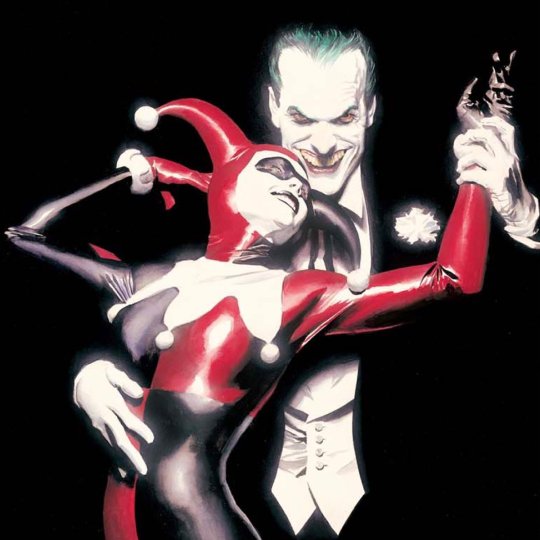
1. The Joker & Harley Quinn, from Batman.
Yep. It’s finally time. You all knew this one was coming. And yes, I’m including Harley here, too: while I’ve personally become a bit annoyed with Harley’s ridiculous levels of misused popularity over the years - and nowadays she barely even counts as an “evil” clown, a lot of the time - I’d feel remiss to leave her out of the running entirely. The fact that it bothers me so many of her redesigns and reinventions almost seem to forget the fact she’s meant to evoke the iconography of a classic clown and jester should say something on its own. However, I’ll admit it’s mostly the Joker we’re talking about here. The Clown Prince of Crime is arguably the most famous supervillain of all time, and is one of the longest-lasting killer clowns on this countdown: he’s been around since 1940. I think the only clowns who have been around longer than him are Pagliacci and Punchinello; considering the latter has been around since the 17th century, and the former has been around since the late 1800s…yeah, I’d say the Joker’s near-85-year-run is still pretty darn impressive. If you need proof of just how much influence this character has had on me, if nothing else, you don’t even have to look at other things I’ve written; just go back over this list and see how many times I hinted at the Joker’s arrival, and how many characters here bear some resemblance - however intentional or not - to the Ace of Knaves. There’s really not much more I even need to say to justify this decision: in my opinion, the Joker (and, to a lesser degree, dear Harley Quinn) are the ultimate couple of Evil Clowns. “Laugh, clown, laugh.”
HONORABLE MENTIONS INCLUDE…
Sweet Tooth, from Twisted Metal. (I don’t really know anything about this character or these games, but from what little I’ve learned, he seems fun in an utterly horrifying way.)
The Clown Doctors, from Pee-Wee’s Big Adventure. (Also the Clown Statue. Lots of evil clowns here.)
The Fireman Clown, from The Brave Little Toaster. (GOOD LORD, THIS THING WAS SCARY.)
Krusty the Clown AND Sideshow Bob, from The Simpsons. (Not sure how much either of these guys count - Krusty seems more “cynical” than “evil,” and Bob barely even qualifies as a clown - hence why they’re only Honorable Mentions.)
The Clown Doll, from Poltergeist. (I felt this fit more in the vein of “creepy toys” than “evil clowns,” but still worthy of an Honorable Mention.)
Mad Pierrot, from Cowboy Bebop. (He may not wear makeup in the original anime, but I still say he counts.)
#list#countdown#best#favorites#horror#villains#evil clowns#killer clowns#scary clowns#halloween#top 15#joker#harley quinn#batman#dc#pennywise#stephen king's it#pennywise the dancing clown#chief clown#doctor who#star trek voyager#ghost clown#scooby-doo#kefka palazzo#final fantasy#rascal#glitter force#smile precure#smile! pretty cure#umlaut
15 notes
·
View notes
Text
An introduction to VR passenger carriages, part 1: the blue carriages
In our next series of introducing our rolling stock, we will be looking at passenger carriages. I was actually thinking of doing multiple units next, but @hapotonradio requested I do the blue carriages and a lot of people seemed to like the idea so here we go.

A Dr13-hauled train consisting of blue carriages arriving in Turku Harbour, 1995. Falk1, Wikimedia Commons
I can already hear foreigners (and non-rail enthusiast Finns too) going "what the hell are the blue carriages?" Well, the blue carriages were/are the first Finnish steel-bodied passenger carriages, with over 600 units (depending a bit on what you count as being actual blue carriages) of different types built between 1961 and 1986. Today, almost all of them have been retired. Which is a shame, because they were sexy.
The first 15 blue carriages were built by the West German Maschinenfabrik Esslingen, who also designed them, in 1961. This original batch were equipped with different types of boggies, from which the Minden-Deutz boggie was chosen for the eventual mass-produced series built in-house by the VR Pasila workshop starting from 1964 (Valmet also built a small number of carriages).
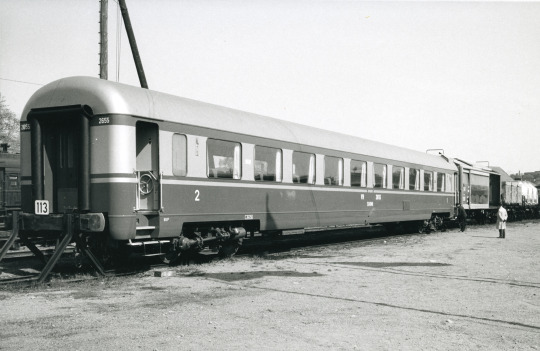
A combined 1st and 2nd class carriage as built, 1964. At this point they still had steel covering the underbody from the sides. These hems were later removed to better display the arousing technical bits. Olavi Karasjoki, Suomen rautatiemuseo.

President Kekkonen (the bald dude) visiting the above carriage. Olavi Karasjoki, Suomen rautatiemuseo.
The initial batch consisted of ten 2. class carriages (littera Eit), four combined 1. and 2. class coaches (lit. CEit) and one 1. class coach (lit. Cit). As you can maybe figure out, the -t at the end stood for teräs, steel, to distinguish from the old wood-bodied coaches. In addition to the regular first- and second-class coaches, the blue carriages' base design was adopted for restaurant cars (litteras Rbkt, Rt, Rkt and Rk), combined condutor's and luggage cars (lits. Fot, Efit and Efiti), sleepers (CEmt), aggregate cars to use on non-electrified tracks (Eifet), carriages with children's playrooms (ELht), postal carriages (Pot), military transport (Ems), prisoner transport (Nom), special carriages for the president and cabinet (A), and even a one-off disco carriage. The latter in particular fucked severely. All those sweaty bodies having it on inside a train...
Some sources also list the Eil-class local traffic coaches as blue carriages, but since they had some structural differences and were originally painted red rather than blue, I'm going to cover them in a separate entry.

Interior of a 2nd class carriage. My photo
Over the quarter of a century the blue carriages were in production, numerous improvements were made to the original design; most notably, the original top service speed of 120 km/h was increased first to 140 km/h and then to 160 km/h in some units.
By the time the last blue carriages were delivered in 1986, their star was already waning. In 1988, the first new Intercity carriages (in a white and red IC delivery) were delivered, and Intercity trains replaced the blue-carriaged special express (erikoispikajuna) trains as the flagship product. With the arrival of the Intercity carriages, and the double-decker carriages from 1998 onwards, the blue carriages were phased out.

Blue carriages at the Turku depot, an Eifet aggregate car repainted in the Intercity livery in the 1990s and CEmt sleepers (both carriages visible behind the Eifet; the sleepers have asymmetric window arrangements). My photo
Today, the only blue carriages still in use in the iconic original livery as sleepers in night trains to Lapland, and prison transport carriages. Some restaurant cars, aggregate cars and conductor's carriages still exist, but they have been repainted in the newer liveries. Several blue carriages have also been preserved by different instances and they're relatively commonly seen in heritage/museum trains these days.
57 notes
·
View notes
Note
i like your new icon <3 is cute
THAAANK YOU. youll never believe tbis i made eit mysbelf :>
10 notes
·
View notes
Text
Favs (long read)
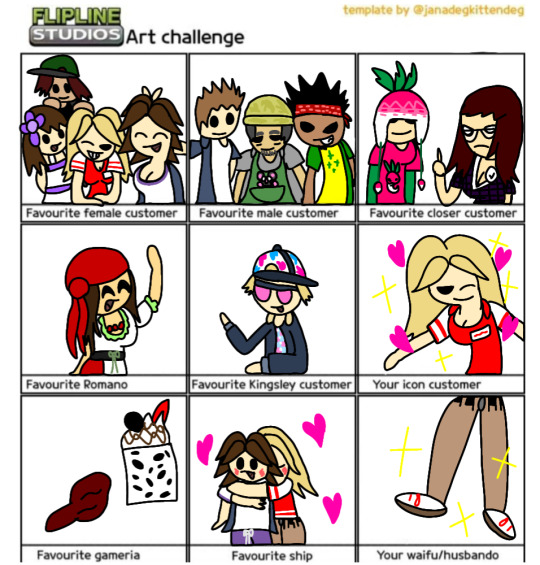
template from @janadegkittendeg (not sure if they have a tumblr ot not)
Sue, Mary, Penny and Scooter: Penny and Scooter are kinda equal to me in terms if how I like them, I think they're cool. I might do a Scooter headcannon post. Mary is my 2nd favorite character due to headcannons of her and how wholesome the ship is and Sue is my favorite papa louie character. If I were to make ocs based off of characters it might be these 4. Mandi was gonna be here but she's an irl person.
James, Skip and Alberto: I'm not sure who's my fav outta these 3, they're pretty great. I do think out of characters you can play as, Alberto and Penny are the best. I don't know why I like Skip and James. I was gonna put Matt and Tony but they're irl people. They probably overthrow these 3 tho.
Quinn and Radylnn: I used to not like these 2, but I eventually really liked them. Xandra was gonna be here but Quinn and Radylnn are better.
Bruna: Ngl I don't care for any of the ramanos. But if there were one I like the most it's Bruna. I don't have a lot to say for her.
Nye: I don't really care for any of the customerzoppa whatever the fuck it's called customers. But Nye is the only one who I like. I don't have a lot to say about him but he's cool.
Sue: I didn't know what icon character meant but I think it's like your fav or something but definitely Sue. I relate to Sue a lot.
Frezzeria and Wingeria: I finished flash Frezzeria and had a really fun time with it. Probably out of the first 4 the most repayable and not wanting to quit by playing 2 days each day, maybe tacomia cause sue is early. I need to try Frezzeria deluxe tho. Wingeria despite not being over like rank 10 is really fun. Out if them the most underrated. Great playable character options (Chuck and Mandi but I'll always choose Mandi) I need to play these games beyond like rank 2 and 10. This is why I'm going to get the 2 go/HD versions soon.
Mary x Sue: The best ship hands down. I feel like the other canon ships don't have much going on or interesting to do with them unless you try hard enough. But this one you can do a lot. I won't explain them all but see my Sue and Mary headcannon posts. If there were to be a TV show or something I would happy if it they were the only ones. They're that good to me.
(I sadly however don't see them married yet or have any children or see them over 30. Just cause Sue's flipdeck and Mary's cart mentions long standing and old truck met its end doesn't mean they were born in the 1980s. I just can't see them being old.)
Sue: I imagine her being really hot. I don't think I need to explain much.
11 notes
·
View notes
Text
Music Journalism (5017)
Picture this; It's 1983, you're sitting in the Hollywood Pantages Theatre, the lights dim and a sole man walks onto the stage holding a cassette player and an acoustic guitar. The backdrop has no colour and no change in stage level. Nothing to suggest that you were about to witness one of if not the greatest live performances/albums of all time. The crowd cheers and applaud as the man approaches the mic “Hi i gotta tape i wanna play”.
Released in 1984 Talking Heads' now iconic ‘Stop making sense’ is both a live album and film shot across a string of shows at the Pantages Theatre in December of 1983. The concept of the show was to slowly introduce the wide variety of instruments used throughout the set which helped shape and influence Talking heads. The first song played was ‘Psycho Killer’ in which David Byrne(Guitarist and singer) played a faster, acoustic yet poppy version of the slow and darker original version from their first album. By the fourth song not only were the four core members on stage but there were backing singers, african drums, a percussionist, an extra guitarist and keyboard player. The stage was stacked with a large arrangement of musicians allowing for an even larger arrangement of genres and styles which gave Talking Heads their unique sound. This ranges from synthesisers to bongos as the band was very much influenced by Afro-beats. Their 1980 album ‘Remain in light’ consisted of tracks with a heavy lean and influence to African music, these same songs particularly (Once in a lifetime and Crosseyed and Painless) feature on Stop making sense. Remain in light paved the way for the band to develop, work together and experiment with African styled music. During the recording of ‘Remain in light’ they were introduced to Fela Kuti who is dubbed the inventor of Afro-beat. Brian Eno who was Talking Heads producer during this time was a massive fan of the musician and shared the album with Talking Heads, which eventually became the framework for ‘Remain in Light’. He states “I remember the first time I listened and how dazzled I was by the groove and rhythmic complexity”. The influence of African style music really helps push the energy of their songs and creates a wide dynamic of sounds which captivates the listener through the contrast of sounds and instruments which sees Western and African cultures connect. This influence carried on throughout their later albums and helped the band become pioneers of ‘new wave’.
One of the main reasons Stop making sense is so well known and considered one of the greatest performances is due to its continuous energy and the ability to entertain and perform so well. Throughout the performance every member is so into the music, you can tell by their movement, facial expressions and especially through the way they interact with each other. One of my favourite moments is when David turns to the backing singers and they all dance in unison to the beat of the music. The energy and enthusiasm reflects onto the rest of the band which ultimately turns it from a show into an exciting experience and makes you feel more part of the show. The movement and choreography is so simple but yet so effective. If you were to watch closely you would notice 90% of the choreography and dancing has some form of jumping involved. This to me is done deliberately as it adds so much energy to the performance and allows for some iconic moments. For example at one point the whole band are all running on the spot all in unison, it's a show which has a big focus on feeling the music and having energy to move! It's a great way to interact with the crowd and really get them moving.
Stop Making Sense has become iconic with musical lovers all over the world through not only its fantastic artistry and raw energy but through its never-before-seen stage set up and outfits . What I personally find fascinating about the show is that the colours throughout are very neutral. The lighting is either white or peach coloured with no serious flashing or change in colour. The background is once again plain with only still images and small colour. Stop making sense as a performance concept is an anomaly, the lack of colour throughout the show and the bland clothing in which compared to artists like Michael Jackson or David Bowie makes it stand out and different. It gives the sense that the focus is on the music rather than the performance. This links to the message that David Byrne is trying to convey and it can be seen through his iconic large suit. David expresses that the big suit came from the idea that “music is very physical, and often the body understands it before the head”. Byrne said this was the idea behind the big suit .The suit remains a symbol for the band's legacy and is shown through examples of people having tattoos and dressing up in big suits on halloween. In an interview on the Letterman show David is asked about his odd movement on stage during ‘Psycho Killer’ To which he replies “It's the music, it's hitting me”. His musical influences and quirky, weird persona helps firment the performance as an all time great. It also helps portray Byrnes message that music is meant to be felt and not just used as a way to experience fake personas and big colourful lights. This can often dampen the actual music, or at least this is what I think the neutral colours and clothing is telling us as a viewer.
For me ‘Stop making Sense’ is a timeless all time great concert film which shows a great band of the era performing at their very best. The artistry throughout is amazing, the stage, the crew, the idea behind it all and the energy that is given off helps build an amazing show and film. This concert film for me is the greatest live performance ever recorded.
Ferrier, A. (2022). The music that inspired Talking Heads' seminal album 'Remain in Light'. Far Out.
https://faroutmagazine.co.uk/the-music-that-inspired-talking-heads-album-seminal-remain-in-light/
Quirk, j. (2021). One memorable look: Mr David Byrnes Supersized suit. Mr Porter.
https://www.mrporter.com/en-gb/journal/fashion/one-memorable-look-david-byrne-supersized-suit-9979044
youtube
0 notes
Text
6 Things You Might Not Know About Structural Engineers
When we think about the marvels of modern architecture, we often envision the iconic buildings and bridges that grace our skylines. However, behind these awe-inspiring structures stand a group of professionals who play a pivotal role in ensuring their safety and stability – structural engineers. While their work is often behind the scenes, here are 7 things you might not know about these unsung heroes of the construction world.
I. The Role of Structural Engineers

Structural engineers design and build the structures that we rely on every day, such as our homes, schools, hospitals, and bridges. They make sure that these structures are safe, strong, and can withstand the forces of nature.
Structural engineers use their knowledge of math, physics, and engineering principles to design structures that can support their own weight, as well as the weight of people, furniture, and other objects. They also consider the forces that the structure will be exposed to, such as wind, snow, and earthquakes.
Structural engineers play a vital role in our society. They help to ensure that the structures we use are safe and reliable.
Simpler explanation of the role of structural engineers:
Structural engineers build the things that hold us up.
They design and build the skeletons of buildings, bridges, and other structures. Structural engineers make sure that these skeletons are strong enough to support the weight of the structure and the people and things inside. They also make sure that the structures can withstand natural forces like wind, snow, and earthquakes.
Structural engineers are important because they help to keep us safe. They design and build the structures that we rely on every day.
II. Educational Background
A professional structural engineer is a challenging but rewarding career path. It requires a strong foundation in mathematics and science, as well as the ability to solve complex problems and think critically. Structural engineers play a vital role in society, designing and constructing the buildings, bridges, and other infrastructure that we rely on every day.
To become a structural engineer in the United States, you must first earn a bachelor's degree in civil or structural engineering from an accredited university. After graduation, you must pass the Fundamentals of Engineering (FE) exam to become an Engineer in Training (EIT). Once you have gained four years of experience working under a licensed professional engineer, you can take the Principles and Practice of Engineering (PE) exam to become a licensed professional engineer.
Education and Training, structural engineers must also possess a number of key skills:
Strong analytical and problem-solving skills
Ability to think critically and creatively
Excellent communication and teamwork skills
Attention to detail and accuracy
Knowledge of engineering software and design tools
Structural engineers can work in a variety of settings, including private engineering firms, government agencies, and construction companies. They may be involved in the design of new structures, the renovation of existing structures, or the inspection and maintenance of existing structures.
Structural engineering is a challenging but rewarding career path. Structural engineers have the opportunity to make a real difference in the world by designing and constructing safe, reliable, and sustainable structures.
III. Diverse Specialisations
Structural engineers design and build the structures that we rely on every day, such as buildings, bridges, and roads. They have many different specializations, which include:
Building engineering: Designing and building houses, offices, and other types of buildings.
Bridge engineering: Designing and building bridges of all sizes and types.
Earthquake engineering: Designing and building structures that can withstand earthquakes.
Structural dynamics: Studying how structures behave under dynamic loads, such as wind and earthquakes.
Structural materials engineering: Developing and testing new materials for use in construction.
IV. Iconic Projects
Project: Eiffel Tower Location: Paris, France Engineer: Gustave Eiffel Completed: 1889
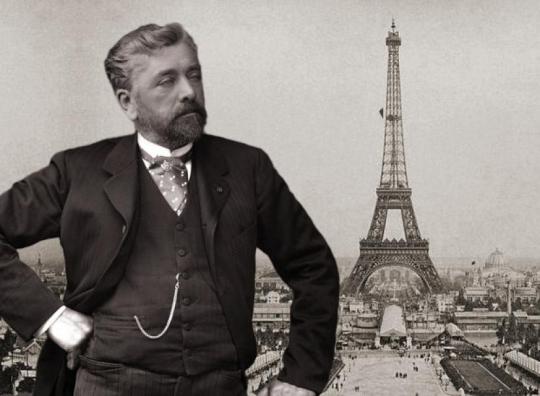
The Eiffel Tower is one of the most iconic structures in the world, and its intricate lattice design is a testament to the brilliant mind of its engineer, Gustave Eiffel. The tower was built for the 1889 World's Fair, and it quickly became a symbol of Paris and France.
Eiffel's design for the tower was revolutionary at the time. It was the tallest structure in the world, and its use of wrought iron was unprecedented. Eiffel also used a new construction technique called cantilever construction, which allowed him to build the tower without the use of temporary scaffolding.
The Eiffel Tower is 1,063 feet tall and weighs over 7,300 tons. It is supported by four massive pillars that are connected by a series of trusses and beams. The tower's lattice design is not only aesthetically pleasing, but it is also incredibly strong and lightweight.
The Eiffel Tower has stood the test of time, and it remains one of the most popular tourist destinations in the world. It is a testament to the brilliance of Gustave Eiffel and the skill of the engineers and workers who built it.
Project: Burj Khalifa Location: Dubai, United Arab Emirates Engineer: Adrian Smith Completed: 2010

The Burj Khalifa is the tallest building in the world, and it is a marvel of modern engineering. The tower is 2,717 feet tall and has 163 floors. It is made of concrete and steel, and it is supported by a massive foundation that is over 160 feet deep.
The Burj Khalifa was designed by Adrian Smith, a world-renowned architect and engineer. Smith used a number of innovative design features to make the tower possible, including a Y-shaped floor plan and a system of buttresses that help to support the tower's weight.
The Burj Khalifa is home to a variety of businesses and residences, including hotels, restaurants, offices, and apartments. It is also a popular tourist destination, with millions of people visiting each year to take in the views from the tower's observation deck.
Project: Golden Gate Bridge Location: San Francisco, California Engineer: Joseph Strauss Completed: 1937
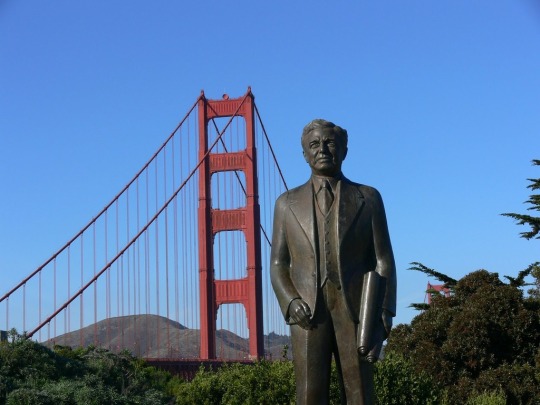
The Golden Gate Bridge is one of the most iconic bridges in the world, and it is a marvel of engineering. The bridge is 1.7 miles long and spans the Golden Gate, the entrance to San Francisco Bay. It is supported by two massive towers that are each over 746 feet tall.
The Golden Gate Bridge was designed by Joseph Strauss, a world-renowned bridge engineer. Strauss used a number of innovative design features to make the bridge possible, including a suspension system that uses two massive cables to support the bridge's deck.
The Golden Gate Bridge is a popular tourist destination, and it is also a vital transportation link between San Francisco and the North Bay. It is a testament to the brilliance of Joseph Strauss and the skill of the engineers and workers who built it.
These are just a few examples of the many iconic structures that have been built by structural engineers. Their work has changed the world in countless ways, and it continues to inspire us today.
V. Innovations and Advancements
Structural engineers use technology to design and build better structures. For example, they use 3D printing to create complex structures that would be difficult or impossible to build using traditional methods. They also use sustainable design principles to create structures that are good for the environment. And they use smart materials to design structures that can adapt to their environment and improve their performance.
Specific Innovations and Advancements:
3D printing: 3D printing is being used to create bridges, houses, and other structures.
Sustainable design principles: Structural engineers are increasingly using sustainable materials, such as recycled concrete and timber, and designing structures to be energy-efficient.
Smart materials: Smart materials are materials that can respond to changing conditions, such as temperature, pressure, or stress. Structural engineers are beginning to use smart materials to design structures that can adapt to their environment and improve their performance.
VI. The Future of Structural Engineering: A Professional Perspective

The future of structural engineering is bright, with new technologies and materials emerging all the time. Structural engineers will play a vital role in addressing some of the world's most pressing challenges, such as climate change, urbanization, and sustainability.
Professional perspectives on the future of structural engineering:
Structural engineers are at the forefront of developing new and innovative ways to design and build structures that are safe, sustainable, and resilient. The future of structural engineering is bright, and I am excited to see what the next decade brings." - Dr. Sarah Billington, Professor of Structural Engineering at the University of Cambridge
Structural engineers have a vital role to play in addressing the world's most pressing challenges, such as climate change and urbanization. In the future, structural engineers will need to be more creative and innovative in their designs, and they will need to work closely with other professionals to create sustainable and resilient infrastructure." - Mr. David Odeh, President of the Structural Engineering Institute of the American Society of Civil Engineers
Conclusion:
Structural engineers are the ones who make sure that our buildings and bridges don't fall down. They are highly skilled and educated professionals who play a vital role in our society. Structural engineers are constantly innovating and finding new ways to build better and stronger structures. We should appreciate their work and the contributions they make to our world.
0 notes
Text








Love One Icons
Requests Are Open For Concept Photos
#kpop#kpop icons#love one#love one icons#loveone#love one chaei#love one chaei icons#eite chaehyun icons#love one yuna#love one yuna icons
1 note
·
View note
Text




#not sure if i'm gonna go through all of my icons to chang eit but i do like this vibe so there's that#⌜𝑖 𝑎𝑚 𝑡ℎ𝑒 𝑔𝑜𝑑𝑑𝑎𝑚𝑛 𝑏𝑎𝑡ℎ𝑜𝑙𝑒.⌟ : ooc .
7 notes
·
View notes
Text

what is the reason for this
#posts#idk when this was even their icon caus eit isnt anymore#literally the only recent thing abt him i know of is that he came out#(whooping and cheering btw love him for that)
2 notes
·
View notes
Photo






codᥱ_ 𝐈 𝐃 : yangyang @ nct/wayv · ıcons %*
#yangyang icons#yangyang nct icons#nct icons#kpop icons#nct edit#yang yang eit#yangyang#wayv icons#yangyang wayv#yangyang wayv icons#yang wayv icons
25 notes
·
View notes
Text
Like a tiny bear
little paws
ฅʕ •ᴥ•ʔฅ
#only 0.2% of people will understand#reggie rambles#im streaming TA and i had to play thast epiosd eit is ICONIC
13 notes
·
View notes
Text

#chloe got me makng babyyy aayla icons.#& tbh i lov eit lmao#she's so young and precious#and so all over the place.#i lowkey wanna have some more threads in her young verse.#✰ *・゚✧ —— ┊ out of character ( ooc ).
2 notes
·
View notes
Text
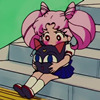
kicks me feet.
#ooc ♡#/my junko muse is only rly awake on discord rn im sorry.#/i may also rework icons again.. idk. i still lvoe the ros epetals tho so maybe not?#/anyways my anxiety ha sbeen wrecking me i pologize deeply for being so here yet not.#/im aware this isnt my personal but also this is my blog so i will like. us eit .#/i admit while i dont care for follower count- im afraid of being unfollowed by my firneds if i go inactive for too long#/thats hwy i still post. even when im not like. rping.
1 note
·
View note
Photo






Pride month is almost over so for one last,,, here are some Klance pride icons!! Feel free to use!
#pride icons#pride month#klance#icons#klance icons#shitty.edits#raf.edit#eits#my edits#give me cred tho?? ^^#klance pride#klance pride month#bisexual klance#pansexual klance#asexual klance#non binary klance#lgbt klance#demisexual klance#keith and lance#lance and keith#laith#laith icons
37 notes
·
View notes